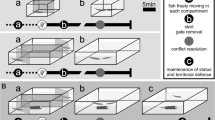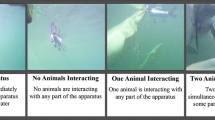Abstract
The present paper highlights the relationship between social status and production of gradual frequency rises in interacting Apteronotus albifrons. The gradual frequency rise production was mathematically inferred and a discrete classification deliberately avoided. The results showed little gradual frequency rise production before the hierarchy settlement. Afterwards, only the dominant fish kept this gradual frequency rise production at low levels, while the subdominant fish drastically increased it in all following interaction contexts. The hypothesis of gradual frequency rises being involved in communication as submissive signals was thus strengthened.




Similar content being viewed by others
Abbreviations
- EOD:
-
electric organ discharge
- FM:
-
frequency modulation
- GFR:
-
gradual frequency rise
- IQR:
-
interquartile range
- JAR:
-
jamming avoidance response
References
Bakeman R, Gottman JR (1997) Observing interaction: an introduction to sequential analysis. Cambridge University Press, Cambridge
Bullock TH (1969) Species differences in effect electroreceptor input on electric organ pacemakers and other aspects of behavior in electric fish. Brain Behav Evol 2:85–118
Bullock TH (1970) The reliability of neurons. J Gen Physiol 55:565–584
Dunlap KD (2002) Hormonal and body size correlates of electrocommunication behavior during dyadic interactions in a weakly electric fish, Apteronotus leptorhynchus. Horm Behav 41:187–194
Dunlap KD, Pelczar PL, Knapp R (2002) Social interactions and cortisol treatment increase the production of aggressive electrocommunication signals in male electric fish, Apteronotus leptorhynchus. Horm Behav 42:97–108
Engler G, Zupanc GKH (2001) Differential production of chirping behavior evoked by electrical stimulation of the weakly electric fish, Apteronotus leptorhynchus. J Comp Physiol A 187:747–756
Engler G, Fogarty CM, Banks JR, Zupanc GKH (2000) Spontaneous modulations of the electric organ discharge in the weakly electric fish Apteronotus leptorhynchus: a biophysical and behavioral analysis. J Comp Physiol A 186:645–660
Hagedorn M, Heiligenberg W (1985) Court and spark: electric signals in the courting and mating of gymnotid fish. Anim Behav 33:254–265
Heiligenberg W (1986) Jamming avoidance responses: model systems for neuroethology. In: Bullock TH, Heiligenberg W (eds) Electroreception. Wiley, New York, pp 613–649
Hopkins CD (1972) Sex differences in electric signalling in an electric fish. Science 176:1035–1037
Hopkins CD (1974a) Electric communication in the reproductive behavior of Sternopygus macrurus (Gymnotoidei). Z Tierpsychol 35:518–535
Hopkins CD (1974b) Electric communication: functions in the social behavior of Eigenmannia virescens. Behaviour 50:270–305
Kramer B (1990) Electrocommunication in teleost fishes. Behavior and experiments. Springer, Berlin Heidelberg New York
Langner G, Scheich H (1978) Active phase coupling in electric fish: behavioural control with microsecond precision. J Comp Physiol 128:235–240
Larimer JL, MacDonald JA (1968) Sensory feedback from electroreceptors to electromotor pacemaker centers in gymnotids. Am J Physiol 214:1253–1261
Moortgat KT, Keller CH, Bullock TH, Sejnowski TJ (1998) Submicrosecond pacemaker precision is behaviorally modulated: the gymnotiform electromotor pathway. Proc Natl Acad Sci USA 95:4684–4689
Schwassmann HO (1971) Circadian activity patterns in gymnotid electric fish. In: Menaker M (ed) Biochronometry. National Academy of Science, Washington DC, pp 186–199
Tallarovic SK, Zakon HH (2002) Electrocommunication signals in female brown ghost knifefish, Apteronotus leptorhynchus. J Comp Physiol A 188:649–657
Zupanc MM, Engler G, Midson A, Oxberry H, Hurst LA, Symon MR, Zupanc GKH (2001) Light-dark-controlled changes in modulations of the electric organ discharge in the teleost, Apteronotus leptorhynchus. Anim Behav 62:1119–1128
Acknowledgements
I wish to thank the whole team of the Zoology Institute of the University of Regensburg (Germany), where this research took place, for their friendly help . The experiments comply with the Principles of animal care, publication No. 86-23, revised 1985 of the National Institute of Health and also with the current laws of Germany and Spain.
Author information
Authors and Affiliations
Corresponding author
Rights and permissions
About this article
Cite this article
Serrano-Fernández, P. Gradual frequency rises in interacting black ghost knifefish, Apteronotus albifrons . J Comp Physiol A 189, 685–692 (2003). https://doi.org/10.1007/s00359-003-0445-8
Received:
Revised:
Accepted:
Published:
Issue Date:
DOI: https://doi.org/10.1007/s00359-003-0445-8




